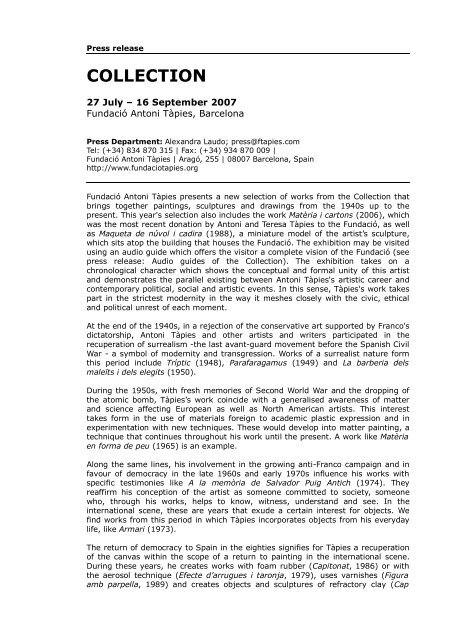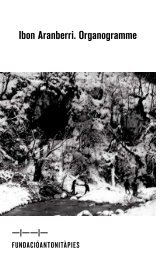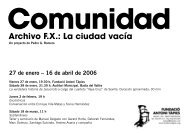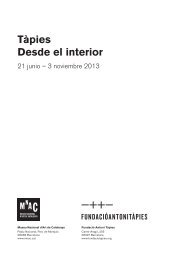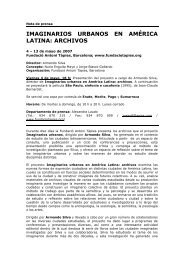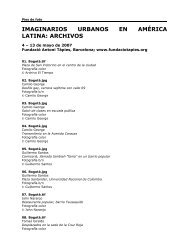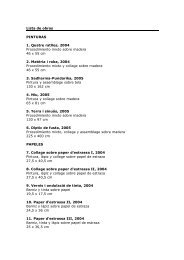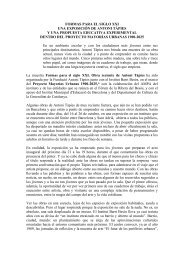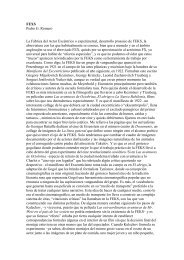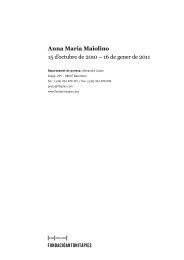COLLECTION - Fundació Antoni Tàpies
COLLECTION - Fundació Antoni Tàpies
COLLECTION - Fundació Antoni Tàpies
Create successful ePaper yourself
Turn your PDF publications into a flip-book with our unique Google optimized e-Paper software.
Press release<br />
<strong>COLLECTION</strong><br />
27 July – 16 September 2007<br />
<strong>Fundació</strong> <strong>Antoni</strong> <strong>Tàpies</strong>, Barcelona<br />
Press Department: Alexandra Laudo; press@ftapies.com<br />
Tel: (+34) 834 870 315 | Fax: (+34) 934 870 009 |<br />
<strong>Fundació</strong> <strong>Antoni</strong> <strong>Tàpies</strong> | Aragó, 255 | 08007 Barcelona, Spain<br />
http://www.fundaciotapies.org<br />
<strong>Fundació</strong> <strong>Antoni</strong> <strong>Tàpies</strong> presents a new selection of works from the Collection that<br />
brings together paintings, sculptures and drawings from the 1940s up to the<br />
present. This year's selection also includes the work Matèria i cartons (2006), which<br />
was the most recent donation by <strong>Antoni</strong> and Teresa <strong>Tàpies</strong> to the <strong>Fundació</strong>, as well<br />
as Maqueta de núvol i cadira (1988), a miniature model of the artist’s sculpture,<br />
which sits atop the building that houses the <strong>Fundació</strong>. The exhibition may be visited<br />
using an audio guide which offers the visitor a complete vision of the <strong>Fundació</strong> (see<br />
press release: Audio guides of the Collection). The exhibition takes on a<br />
chronological character which shows the conceptual and formal unity of this artist<br />
and demonstrates the parallel existing between <strong>Antoni</strong> <strong>Tàpies</strong>'s artistic career and<br />
contemporary political, social and artistic events. In this sense, <strong>Tàpies</strong>'s work takes<br />
part in the strictest modernity in the way it meshes closely with the civic, ethical<br />
and political unrest of each moment.<br />
At the end of the 1940s, in a rejection of the conservative art supported by Franco's<br />
dictatorship, <strong>Antoni</strong> <strong>Tàpies</strong> and other artists and writers participated in the<br />
recuperation of surrealism -the last avant-guard movement before the Spanish Civil<br />
War - a symbol of modernity and transgression. Works of a surrealist nature form<br />
this period include Tríptic (1948), Parafaragamus (1949) and La barberia dels<br />
maleïts i dels elegits (1950).<br />
During the 1950s, with fresh memories of Second World War and the dropping of<br />
the atomic bomb, <strong>Tàpies</strong>’s work coincide with a generalised awareness of matter<br />
and science affecting European as well as North American artists. This interest<br />
takes form in the use of materials foreign to academic plastic expression and in<br />
experimentation with new techniques. These would develop into matter painting, a<br />
technique that continues throughout his work until the present. A work like Matèria<br />
en forma de peu (1965) is an example.<br />
Along the same lines, his involvement in the growing anti-Franco campaign and in<br />
favour of democracy in the late 1960s and early 1970s influence his works with<br />
specific testimonies like A la memòria de Salvador Puig Antich (1974). They<br />
reaffirm his conception of the artist as someone committed to society, someone<br />
who, through his works, helps to know, witness, understand and see. In the<br />
international scene, these are years that exude a certain interest for objects. We<br />
find works from this period in which <strong>Tàpies</strong> incorporates objects from his everyday<br />
life, like Armari (1973).<br />
The return of democracy to Spain in the eighties signifies for <strong>Tàpies</strong> a recuperation<br />
of the canvas within the scope of a return to painting in the international scene.<br />
During these years, he creates works with foam rubber (Capitonat, 1986) or with<br />
the aerosol technique (Efecte d’arrugues i taronja, 1979), uses varnishes (Figura<br />
amb parpella, 1989) and creates objects and sculptures of refractory clay (Cap
embenat, 1981) or of bronze (Crani 376, 1987). On the other hand, toward the end<br />
of this decade his interest for eastern cultures is reinforced. This concern had<br />
already incubated during the years after the Civil War and went on to become a<br />
fundamental philosophical influence in his work for its emphasis on materials, for<br />
the identification of man with nature and denial of western dualism. Likewise,<br />
<strong>Tàpies</strong> feels influenced by a new generation of scientists that support a vision of the<br />
universe that understands matter as a whole which is subject to change and<br />
constant formation.<br />
In the 1990s, his interest in eastern art and philosophy increases, as can be seen in<br />
works like Trio (díptic) (1994), an homage to the Japanese monk Sengai and his<br />
teachings. In recent years, <strong>Tàpies</strong> has returned to his origins, with a clear desire to<br />
reaffirm and consolidate criteria. The presence of matter is also renewed in the<br />
works of this period which indicates that everything participates in the continuing<br />
impulse to form, transform or deform which is dictated by the rhythm of the<br />
universe (Dues formes, 1999; Matèria i cartons, 2006). Likewise, the fragmented<br />
body reappears (1/2, 2003) often represented on a larger-than-life scale.<br />
Amplifying a small and simple body, <strong>Tàpies</strong> makes it cosmic. This is one of the keys<br />
that the artist has wanted to show throughout his career.<br />
<strong>Fundació</strong> <strong>Antoni</strong> <strong>Tàpies</strong>. July 2007


